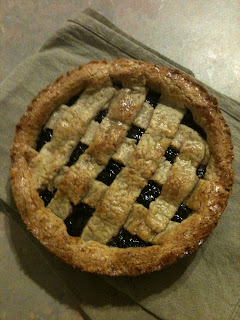Basically it's a cross between a cake and a pastry, made with hazelnut or almond meal, with a lattice top and a filling of blackcurrant or raspberry jam.
 |
| detail of the pastry lattice |
Fleischer's got me through many years of Saturday morning treats and the occasional cake for special occasions. I was delighted to see that Lori Leidler (Mr Fleischer) had contributed the recipe for his awesomely good Linzer Torte to Dean Brettscheider and Lauraine Jacobs's book Baker: The best of International Baking from Australian and New Zealand Professionals (Allen & Unwin, 2001).
I think Mr Leidler was being a bit sneaky though, because when I first made it, it didn't taste like the one I always had at Fleischer's. But when I replaced the ground almonds in his recipe with ground hazelnuts, it got a lot closer. AHAHA Mr Leidler, you can't fool a true Linzer devotee :-)
As there are some lovely people around me who are dietarily challenged, I experimented and found that this Torte works well as gluten-free and dairy-free (see my asterisks below), although I would always use wheat flour and a good unsalted butter if I have the option.
Linzer Torte
200g plain flour*
1/8 tsp ground cloves
1/4 tsp cinnamon
170g ground hazelnuts
110g castor sugar
1 tsp lemon zest, chopped finely
225g unsalted butter*
2 hardboiled egg yolks, mashed and cooled
2 raw egg yolks, lightly beaten
1/2 tsp vanilla essence
300g blackcurrant jam
glaze: 1 egg and 3 tbsp cream*, mixed together lightly
*for a dairy free option: substitute Nuttelex for butter and leave out the cream from the glaze; for a gluten free option: use a special gluten free flour such as Orgran All Purpose Flour, which is a texture-balanced mixture of maize, corn flour and rice flour - you can get this at health food stores.
Set the oven at 175C. Sieve the flour with the cloves and cinnamon into a large bowl and add the ground hazelnuts, the sugar, lemon zest, the butter (at room temperature) and the mashed hard-boiled egg yolks. Mix well to combine - I did this with bare hands, like the old fashioned way of creaming butter and sugar - this is because you can feel much better if the mixture is well combined. Add the raw egg yolks and the essence and work this into a dough.
Form the dough into a ball - it will be very soft - and wrap in cling film; refrigerate for an hour to firm up.
Butter and flour a Springform cake tim with a removable base, otherwise you'll never be able to get the Torte out of the tin. (Remember if you are going gluten or dairy free you must take care to use your alternative butter and flour substitutes in this process or you will contaminate your cooking.)
Flour a bench top and press out three-quarters of the pastry, reserving the rest in the fridge for later. Using plenty of flour because it will be sticky and soft, gently roll the pastry out to about 1cm thick, or until you have enough to cover the base and halfway up the sides of the tin. If the pastry sticks to the bench (and it will - believe me, it will) use a metal spatula to loosen it from the surface and get it into the tin. Patch any cracks or tears with oddments of pastry and press into the tim firmly.
Pour the jam into the pastry base....
...And spread evenly. A good quality European blackcurrant jam is desirable, although bizarrely, the dreaded Coles has started to produce their own brand which is actually fantastic - points to the evil empire for that one.
Apparently raspberry jam is also acceptable, but for me a true Linzer Torte has blackcurrant filling.
Then take the remaining pastry from the fridge and roll out, cutting into strips about 1.5cm thick and as long as the diameter of the tin. Place the strips in a lattice pattern on top of the jam surface.
I found it difficult to be neat about this because the pastry is so soft - it tends to stretch, crack and stick to everything :-(
Brush the lattice with the egg and cream glaze to add some shine. Replace the Torte in the fridge for half an hour to firm up, then put it straight into the preheated oven and bake for 30-35 minutes, until the pastry is browning at the edges.
Remove from the oven and CAREFULLY run a clean sharp knife around the edge of the torte to loosen the sides from the tin, then leave it to cool and firm up for a while before removing the sides of the tin.
This keeps well for up to a week and can be gently warmed in the oven before serving to freshen it up.
Happy eating!
























